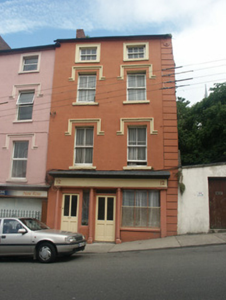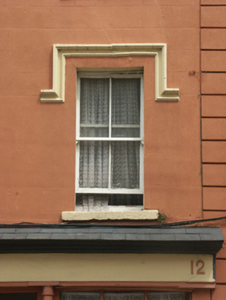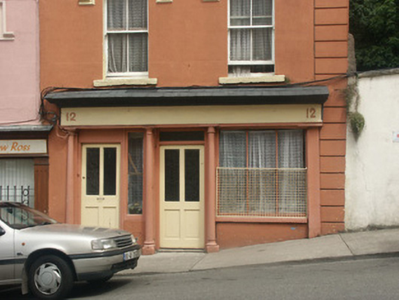Survey Data
Reg No
15605154
Rating
Regional
Categories of Special Interest
Architectural, Artistic
Original Use
House
Historical Use
Shop/retail outlet
In Use As
House
Date
1815 - 1835
Coordinates
271980, 127578
Date Recorded
21/06/2005
Date Updated
--/--/--
Description
End-of-terrace two-bay four-storey house, c.1825, originally terraced. Renovated and refenestrated, c.1900, with shopfront inserted to ground floor. Now disused to ground floor. One of a group of at least five. Pitched slate roof with terracotta ridge tiles, red brick Running bond chimney stack, and iron rainwater goods on rendered eaves having iron ties. Rendered, ruled and lined walls over random rubble stone construction with rendered channelled pier to end over concealed red brick quoins to corner incorporating cast-iron 'bulls eye' tie plate, and part ivy-clad mass-concrete, c.1950, to side (east) elevation. Square-headed window openings with cut-stone sills, concealed red brick block-and-start surrounds, hood mouldings over, moulded rendered surrounds to top floor, and replacement two-over-two timber sash windows, c.1900, retaining three-over-three timber sash windows to top floor. Shopfront, c.1900, to ground floor with engaged colonettes on cut-granite padstones, fixed-pane (single- and three-light) timber display windows, glazed timber panelled door on step having overlight, glazed timber panelled door to house, and fascia having slate-lined moulded cornice. Interior with timber panelled shutters to window openings. Street fronted with concrete footpath to front.
Appraisal
A pleasantly composed house of the middle size built as one of a group of at least five units (including 15605155) making an elegant contribution to the streetscape aesthetic in Mary Street on account of attributes including the vertical emphasis of the massing with the slightly stepped roofline following the gradient or incline in the street, the diminishing in scale of the openings on each floor in the Classical manner producing a tiered visual effect, and so on: meanwhile, accents in contrasting Classical or Tudor styles further enhance the external expression of the composition. Having been well maintained, the house continues to present an early aspect with substantial quantities of the historic fabric surviving in place, both to the exterior and to the interior including a traditional Irish shopfront of artistic design interest making a pleasing impression at street level.





